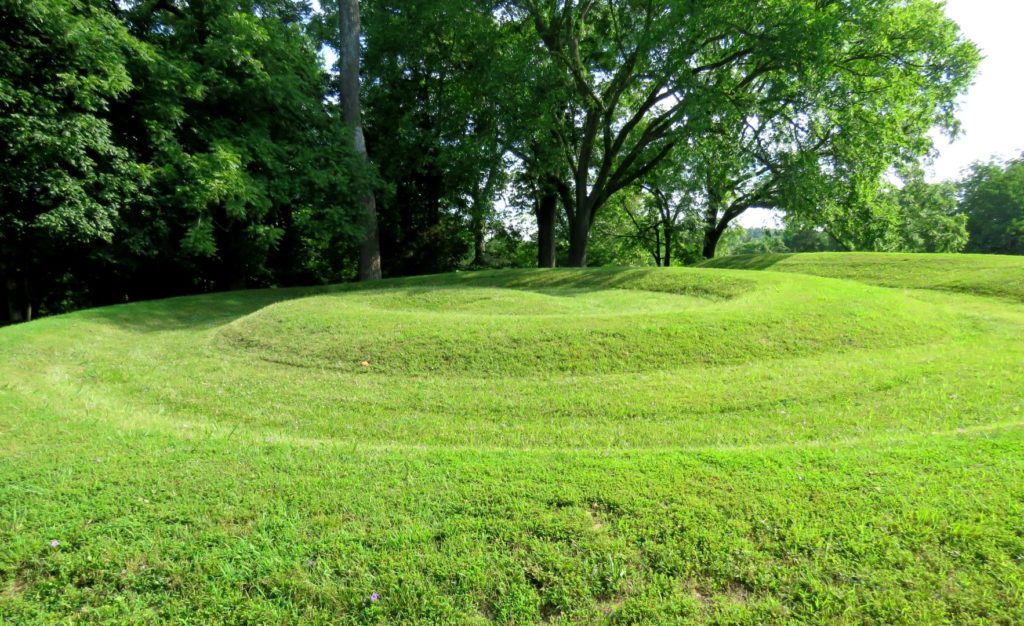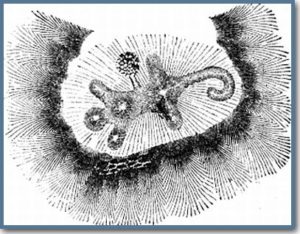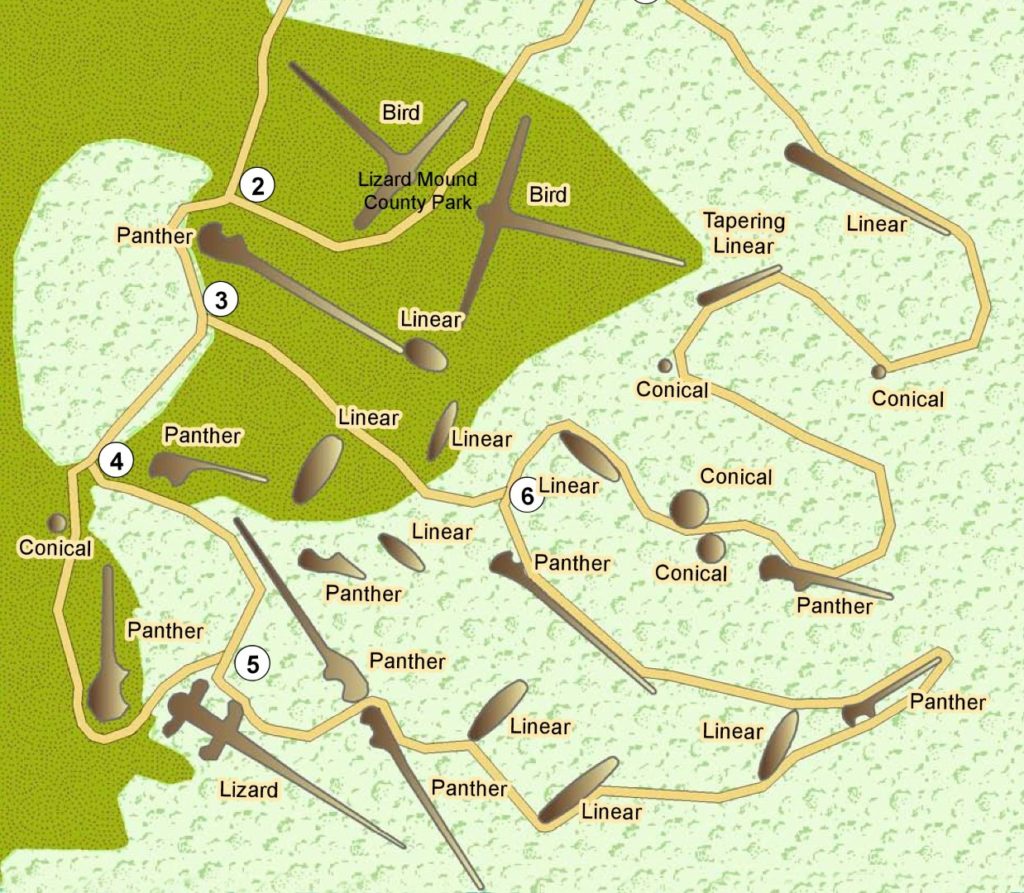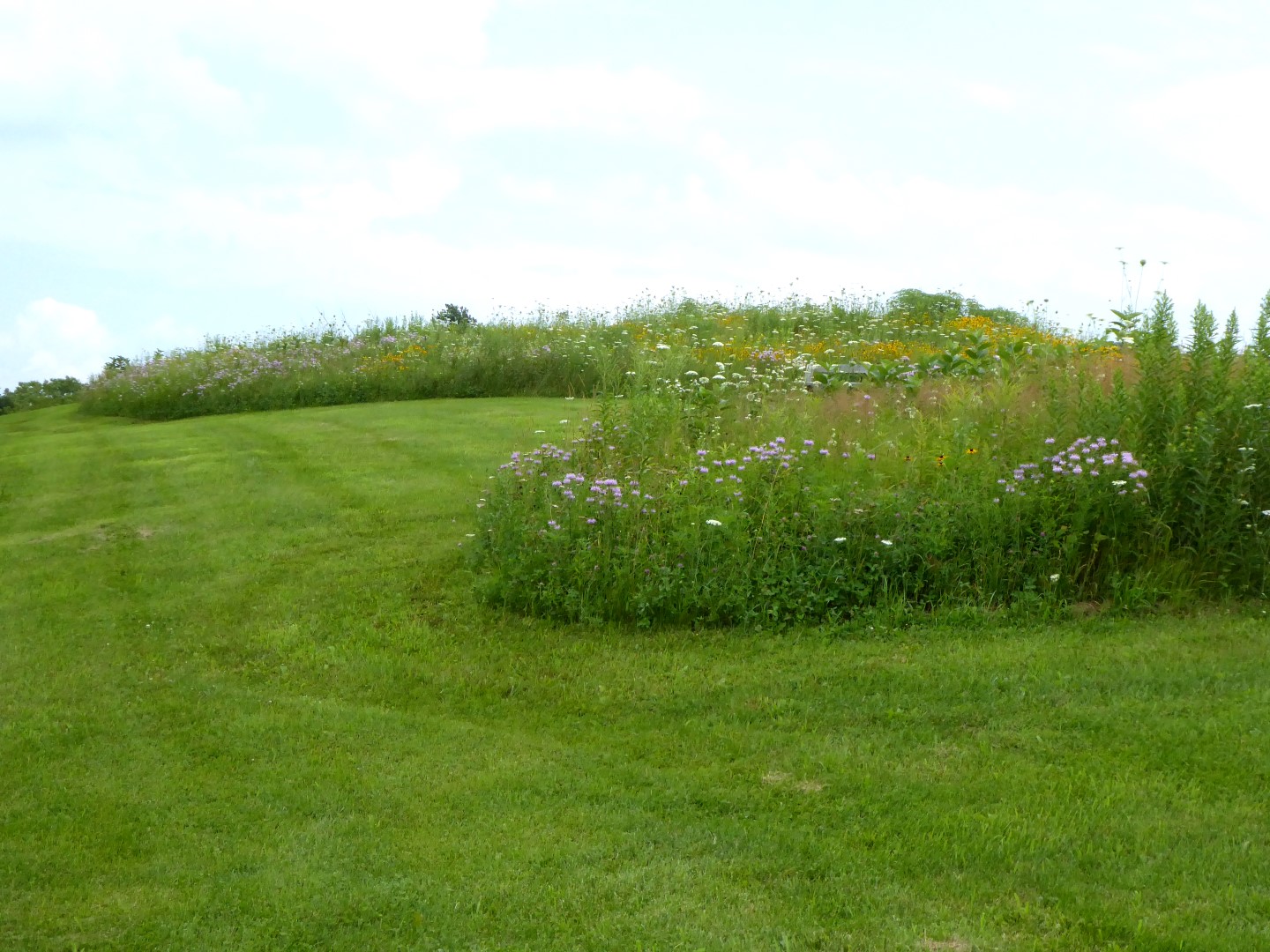 Our souls, to truly thrive, need whole, intact landscapes, even sacredscapes, lands that are revered and ceremonially marked as sacred. On this Indigenous People’s Day I want to honor an aspect of our First People’s heritage — the earth-based spirituality of the ancestors of midwestern Native Americans who created immense, spiritually charged landscapes filled with earth-sculpted animals called effigy mounds.
Our souls, to truly thrive, need whole, intact landscapes, even sacredscapes, lands that are revered and ceremonially marked as sacred. On this Indigenous People’s Day I want to honor an aspect of our First People’s heritage — the earth-based spirituality of the ancestors of midwestern Native Americans who created immense, spiritually charged landscapes filled with earth-sculpted animals called effigy mounds.
Perhaps because I grew up on an island with a limitless view of ocean, sky, and beach I saw the whole vast vista as sacred — God, Spirit, infusing it all. Leaving home, I loved to explore the beauty and special character of the larger terrain wherever I lived. But these were basically lonely pursuits. As far as I could tell, no one else viewed the land, whether the confluence of roiling rivers in Pennsylvania or the cliffs high above the Pacific Ocean in California, as holy. It wasn’t until we began travelling to Ireland that I started to learn about ancient people who saw their land as sacred and marked it reverently, denoted it as sacred space through their creativity. At one ancient stone circle after another we experienced the power of a circular ceremonial enclosure purposely consecrated by being set within a uniquely compelling landscape. Humanly created circles placed in divinely endowed landscapes, each mutually empowering the other.
Many of these 1,000BC stone circles have been preserved in the south of Ireland, along with even older stone passage mounds, ceremonial enclosures, and rock art. These stone circles are not only one with the land, they are also situated within the cosmos. Virtually all have altar-like recumbent stones facing southwest, the direction of death and rebirth, and many are oriented specifically to the solstice or equinox sunrises or sunsets. In my ignorance I didn’t realize that ancestral Native Americans here at home had engaged in similar landscape-scale reverencing. A few years ago I became interested in the huge flat-topped earthen platform or temple mounds, built over the course of 4,000 years by the mound-building cultures east of the Mississippi, when we visited Cahokia near St. Louis, and later when we went to see several temple mounds of the ancestors of the Cherokee in North Carolina, but that’s a whole other story.
Last August I was bitten by a poisonous copperhead snake, which was quite a transformative experience. So, this summer when we went north to visit my husband’s Ojibwe relatives in Wisconsin, I wanted to make a pilgrimage to the Serpent Mound in Ohio to pay homage to and make peace with Snake. The Serpent Mound, created around 1,000AD, is held sacred by many contemporary Native Americans. We arrived before the park opened and had the place to ourselves. In the profound green quiet and slanting radiance of the morning sun we made our offerings and began our slow approach.

The Serpent is a 1,350 foot long earthen effigy figure representing the Great Serpent, Guardian of the World Below, the watery realm of lakes and rivers under the earth. Arising from the underwater/underworld realm, the Serpent undulates along the flat plateau of a high bluff, bordered by snakelike meandering creeks below. The curve of the snake fits the curve of the land as the land shapes the body of the snake, one sanctifying the other. My body experienced the serpent’s subtle body as the tangible presence of the animated energies of water and earth in the never-ending process of fertility awakening, unwinding, creating. Tail still tightly coiled in a sunwise triple-spiral, the serpent holds an egg in its mouth. The sinuous curves felt like the continuous movement of life itself from birth to death to rebirth.

The head of the Serpent faces the summer solstice sunset. Our visit being only two weeks after the solstice, I stood at the snake’s head, at the head of the cliff where the waters meet, in the sunlight, feeling the snake spirit directing me how to sing and pray. I moved within the timeless cycling of the sun, other curves of its body pointing toward the sunrises of winter solstice and the spring and fall equinoxes. (Perhaps stimulated by this ritual contact with serpent energies, shortly after our return home I had a significant dream of a newly awakened flow of psycho-physical energy.)
At the visitors center we learned that there had been ten thousand Native burial mounds and earthworks throughout the Ohio Valley region and, unbelievably, less than five percent of these still remain. In this area there is one other effigy, Alligator Mound, actually an “underwater panther,” a powerful mythological water-spirit of many Native American peoples. It is located on the top of a bluff overlooking the Raccoon Creek Valley.


Continuing north into southeastern Wisconsin, we visited Lizard Mound County Park where a mile-long circular trail winds through earthen effigy figures of birds with widely outstretched wings, a lizard-like water spirit, and many long-tailed, supernatural animals called “underwater panthers,” creatures part cat, part serpent. These are spirits of the three realms of the layered cosmos, upper/sky, middle/earth and lower/water. Sometimes the realms are seen as two worlds, the Above and the Below: sky above, earth and waters below. The Lizard Mound figures are interspersed with very long, tapering linear mounds that are thought to be snakes, underwater spirits, as well. The effigy area is surrounded by springs and wetlands. Besides being sources of life, springs are often revered by Native people as entrances to the world below and as pathways for the spirits to travel between the lower and upper worlds. A park sign informed us, “Mound building was part of a ceremonial ritual meant to unify the spiritual and physical worlds and bring them into balance and harmony.”


Walking the trail in this savanna environment we were accompanied by several species of butterflies, including, happily, many monarchs, who were fluttering among the colorful summer wildflowers.


After visiting with our Ojibwe relatives in northern Wisconsin and attending their Honor the Earth Powwow, we stopped on our way home to visit a cousin’s family in southwest Wisconsin. When we mentioned our interest in effigy mounds they told us that, synchronistically, one of the best preserved effigy mound clusters in the state was nearby. So, we went in search of the Shadewald Mounds, otherwise affectionately known as Frank’s Hill in recognition of the man, Frank Shadewald, who saved them and virtually wrote the book on how to properly preserve them. These mounds are part of what was once a giant ceremonial effigy mound landscape, now mostly destroyed.
We climbed up a high hill and found ourselves walking along beside large, round wildflower-covered shapes. These are a row of twelve conical mounds, following the contours of the hilltop in an almost perfect linear formation, all evenly spaced, in a roughly north/south direction. Frank Shadewald observed that these mounds appear to track the setting sun from May 1st to the summer solstice and back again to around September 1st. This is the approximate time frame within which to plant and harvest corn at that latitude. They also form a calendar of other celestial events like summer solstice, the longest day of sunlight of the year.


To the east we could see that on the top of the next hill were the effigy figures, a row of enormous animal effigies including a bird (perhaps eagle or thunderbird), a bear, and a coyote-like canine, also following the contours of the hilltop. Climbing the second hill we walked around great outspread wings, a massive head and body, but we couldn’t even begin to grasp their full shapes, they were so huge. We wondered at the mystery of what it meant that these animal spirits were ritually created with soil by people standing on the top of the earth and perhaps dancing around them, but they could only be seen by the sky spirits themselves.




Wisconsin has been described as “the sculpted land.” Because of the especially dense concentration of tens of thousands of effigy mounds in the area, southern Wisconsin is considered to be the center of what is called the “effigy mound culture.” Created from 600 to 1200AD, they are the only raised-earth figurative formations in the world. A small percentage of these mounds remain, which are now protected. The people who made these effigies are thought to be the ancestors of the Ho Chunk (Winnebago), Dakota Sioux, and other related tribes. Their stories and legends describe these effigy mounds as sacred sites at which medicine people led ceremonies to secure the ongoing re-creation, rebirth and renewal of the communities of people and the earth. Most of the animal effigies include burials of revered ancestors in the animals’ heart or head area. These are the spirit beings and ancestor spirits of the various animal-symbolized clans interacting with the people in an ever- living landscape. All the animal figures are artfully placed on the land so that they are animated by the flow of the contours of the natural topography. Birds fly up and down slopes, animals range across ridge tops, and water creatures crawl to and from lakes and springs, portals to the watery underworld entered by water spirits, shamans, and the spirits of the ancestors.
We learned that in watery eastern Wisconsin, where lakes, swamps, marshes, and springs are plentiful, the long-tailed water-spirit creatures of the lower world abound, while in southwestern Wisconsin, with its un-glaciated high hills, cliffs and bluffs, upper world birds and earth world bears predominate. Across the middle, the animal congregations are mixed. But whether creatures of the Above or of the Below are more prevalent, they are almost always balanced by the presence of creatures of the other realm. We had unwittingly happened to visit both eastern and western effigy mound configurations.
Now that we mortals can look down from the sky, we see more and more effigies being revealed by the new earth-imaging technology of LiDAR. Seeing those ghostly images of animals ranging along ridgetops and guarding the entrances of river valleys, while great flying birds surround former villages, we witness a sacredscape in which the people lived their lives completely embraced by the spirits of earth, water, and sky. I can barely imagine such a sense of belonging to earth and universe.

Passing back through southern Ohio we hoped to round out this exploration of human creativity in concert with the landscape by stopping to see some of the earthworks of the earlier Hopewell culture, built from about 1AD to 400AD, These are ritual enclosures for ceremony and dancing constructed of low walls of earth and stone in various geometric shapes, many on the flat bluffs above river gorges, these shaped by the shape of the land itself. The Hopewells shared with the later effigy mound builders the same iconography of birds and animals of the layered cosmos, including those water-spirits called underwater panthers. Of some 600 of these earthworks, only about three dozen remain. But we ran out of time and, hopefully, will return to experience and write about them.
Resources:
- “Great Beasts of Legend: Underwater Panthers”, an informative video lecture by Dr. Megan Kassabaum, Weingarten Assistant Curator, American Section, Penn Museum on Underwater Panthers.
- The Indian Mounds of Wisconsin by Robert A. Birmingham and Amy L. Rosebrough.
- Effigy Mounds Initiative, a very active Facebook group.
- Wonderful video lecture on “New Perspective on Wisconsin’s Monumental Earthworks ” with LiDAR images of mound-filled landscapes.
Text (c) 2019 Betty Lou Chaika. Ground photographs (c) Betty Lou and David Chaika
Sharon Mijares
This was new learning for me. Thank you so much for presenting the descriptions and images.
Betty Lou Chaika
Sharon, your’re welcome. Serpent Mound is pretty famous, but, even so, most people I’ve mentioned it to have never heard of it. The other effigy-filled ceremonial landscapes are known even less. Their extent was certainly surprising to me. I think this is because of our long history of denigrating Native Americans.
Ann Loomis
I’m so glad to hear that Columbus Day has been changed to Indigenous Peoples Day, which says to me that we’re finally reconnecting with the sacred landscape. Your article is so informative and the images so inspiring. Thanks for writing this! (Now I know why we didn’t get any mail today–it’s a federal holiday.)
Betty Lou Chaika
Ann, sadly the Federal holiday is still Columbus Day. As I understand it some cities and states, like NC, are proclaiming it Indigenous Peoples Day in addition. I am looking forward, if possible, to going back and seeing more of the protected animal effigies. At least in that area of the midwest, they seem to be gaining more and more interest and respect, finally. Anything that inspires folks to see the Earth as sacred instills hope, right?
arianna
Thank you for sharing about your copperhead encounter and your journey to make peace with The Serpent Mound. We have so much to learn from our animal/natures spirits!
Betty Lou Chaika
Yes, Arianna, and we have so much to learn about honoring our wild animal kin as sacred in their material form as well as their spirit form.
Brian T Stokes
So grateful for the heartquakes rippling through me as I steep in your deep, deliberate and thoughtful sharing of what is right under our feet that we walk over and miss.
My heart is singing!
Betty Lou Chaika
Brian, singer of songs, I think one of your spirit animals must be a bird. But you walk in a sacred manner, solidly grounded on the sacred earth, not missing much!
Ann Loomis
In reading this article over a second time, which I highly recommend doing, I had the insight that the animal effigies are probably gaining more interest and respect because we humans are awakening to our own healing animal instincts. This is due in part to the rise of the feminine soul (as I see it).
Betty Lou Chaika
Thanks, Ann, for contributing this perspective. Yes, the arising of the feminine instinctual energies to balance the over-dominance of the masculine mental energies may help us to again value the animated Earth, as indigenous cultures still do.
Nick Brink
Very Impressive – would like to follow
Betty Lou Chaika
Hi Nick. Thanks, I suspected you might find the story interesting. I will gladly notify you of future posts.
Laurie Lindgren
I find these posts so refreshing and interesting. Thank you so much for going out there and actually visiting all these places and writing about it so that we can learn and enjoy vicariously!
I am fascinated that these large earthworks exist. How in the world were they created on such a large scale without the wheel. And were the indigenous populations as large as the ones in the Middle East and Mesoamerica where the larger stone monuments are? And what was the inner impulse and where did it come from. I am going to take time to reread your post so I can better understand these questions. Human beings are so amazing!
Thank you for your dedicated travels and work on behalf of the planet and all of us creatures who have a “place in the choir!”
Betty Lou Chaika
And thank you, Laurie, for reading them! The travel that excites me is seeing places where people celebrated their relationship with the spirit-filled land through creative rock and earth forms of expressions. The geometric enclosure earthworks were made 100BC-500 AD by people of the Hopewell culture, living in non-urban, non-hierarchical, small-scale societies. This link briefly describes their sun and moon alignments, which I suspect might interest you! http://worldheritageohio.org/hopewell-ceremonial-earthworks/